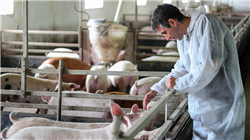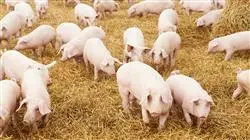University certificate
The world's largest faculty of veterinary medicine”
Introduction to the Program
A complete and total update in Swine Production and Health with the most complete and effective training program on the online educational market"

The profitability of livestock production requires high sanitary standards. Advances in swine production have always evolved in parallel with improvements in animal health.
In spite of the important results achieved in disease control and prevention, there are still sanitary problems in the swine production sector that require a therapeutic solution. The industry continues to be threatened by new or re-emerging diseases, which is why the use of antibacterial treatments is still a necessary tool in pig farming.
However, disease control must be carried out in an integrated manner, on several fronts, such as hygienic measures for cleaning and disinfection, vector control, stress-free animal management, personnel hygiene, visitor control, animal quarantine, isolation and protection of buildings, sanitary vacuum, etc.
The curriculum provides a solid and up-to-date training in Swine Production and Health, successfully addressing the work of veterinary specialists in companies and industries engaged in swine production.
In order to do a good job in the field, the professional must have a solid theoretical knowledge of anatomy, pathophysiology and therapeutics, which they already possess through their higher academic training.
The Postgraduate diploma develops the anatomy and physiology of the species of interest, focusing on the characteristics of each species from a pathophysiological point of view, directly related to animal health.
After completing this training, the veterinary professional will have developed a specialized, broad and interrelated vision of the anatomy and physiology of the animal species under study and will be able to understand in a simple and global way the processes that can affect these individuals.
Join the elite, with this highly effective educational training and open new paths to help you advance in your professional progress"
This Postgraduate diploma in Swine Production and Health contains the most complete and up-to-date scientific program on the market. The most important features include:
- The latest technology in online teaching software
- Highly visual teaching system, supported by graphic and schematic contents that are easy to assimilate and understand
- Practical cases presented by practising experts
- State-of-the-art interactive video systems
- Teaching supported by telepractice
- Continuous updating and recycling systems
- Autonomous learning: full compatibility with other occupations
- Practical exercises for self-evaluation and learning verification
- Support groups and educational synergies: questions to the expert, debate and knowledge
- Communication with the teacher and individual reflection work
- Content available from any fixed or portable device with internet connection
- Supplementary documentation databases are permanently available, even after the Postgraduate Diploma
A complete training program that will allow you to acquire the most advanced knowledge in all the areas of intervention of a specialized veterinarian"
Our teaching staff is made up of professionals from different fields related to this specialty. In this way, we ensure that we provide you with the educational update we are aiming for. A multidisciplinary team of professionals trained and experienced in different environments, who will develop the theoretical knowledge in an efficient way, but above all, they will bring their practical knowledge from their own experience to the Postgraduate diploma: one of the differential qualities of this training.
This mastery of the subject matter is complemented by the effectiveness of the methodological design. Developed by a multidisciplinary team of e-learning experts, it integrates the latest advances in educational technology. This way, you will be able to study with a range of comfortable and versatile multimedia tools that will give you the operability you need in your training.
The design of this program is based on Problem Based Learning: a plan which views learning as an eminently practical process. To achieve it through distance learning we use telepractice. With the help of an innovative interactive video system and “learning from an expert”, you will be able to acquire the knowledge as if you were facing the scenario you are learning at that moment. A concept that will allow you to integrate and consolidate the learning in a more realistic and permanent way.
With the experience of working professionals and the analysis of real success stories, in a high-impact training approach"

With a methodological design based on proven teaching techniques, this innovative Postgraduate diploma will take you through different teaching approaches to allow you to learn in a dynamic and effective way"
Why study at TECH?
TECH is the world’s largest online university. With an impressive catalog of more than 14,000 university programs available in 11 languages, it is positioned as a leader in employability, with a 99% job placement rate. In addition, it relies on an enormous faculty of more than 6,000 professors of the highest international renown.

Study at the world's largest online university and guarantee your professional success. The future starts at TECH”
The world’s best online university according to FORBES
The prestigious Forbes magazine, specialized in business and finance, has highlighted TECH as “the world's best online university” This is what they have recently stated in an article in their digital edition in which they echo the success story of this institution, “thanks to the academic offer it provides, the selection of its teaching staff, and an innovative learning method aimed at educating the professionals of the future”
A revolutionary study method, a cutting-edge faculty and a practical focus: the key to TECH's success.
The most complete study plans on the university scene
TECH offers the most complete study plans on the university scene, with syllabuses that cover fundamental concepts and, at the same time, the main scientific advances in their specific scientific areas. In addition, these programs are continuously being updated to guarantee students the academic vanguard and the most in-demand professional skills. In this way, the university's qualifications provide its graduates with a significant advantage to propel their careers to success.
TECH offers the most comprehensive and intensive study plans on the current university scene.
A world-class teaching staff
TECH's teaching staff is made up of more than 6,000 professors with the highest international recognition. Professors, researchers and top executives of multinational companies, including Isaiah Covington, performance coach of the Boston Celtics; Magda Romanska, principal investigator at Harvard MetaLAB; Ignacio Wistumba, chairman of the department of translational molecular pathology at MD Anderson Cancer Center; and D.W. Pine, creative director of TIME magazine, among others.
Internationally renowned experts, specialized in different branches of Health, Technology, Communication and Business, form part of the TECH faculty.
A unique learning method
TECH is the first university to use Relearning in all its programs. It is the best online learning methodology, accredited with international teaching quality certifications, provided by prestigious educational agencies. In addition, this disruptive educational model is complemented with the “Case Method”, thereby setting up a unique online teaching strategy. Innovative teaching resources are also implemented, including detailed videos, infographics and interactive summaries.
TECH combines Relearning and the Case Method in all its university programs to guarantee excellent theoretical and practical learning, studying whenever and wherever you want.
The world's largest online university
TECH is the world’s largest online university. We are the largest educational institution, with the best and widest online educational catalog, one hundred percent online and covering the vast majority of areas of knowledge. We offer a large selection of our own degrees and accredited online undergraduate and postgraduate degrees. In total, more than 14,000 university degrees, in eleven different languages, make us the largest educational largest in the world.
TECH has the world's most extensive catalog of academic and official programs, available in more than 11 languages.
Google Premier Partner
The American technology giant has awarded TECH the Google Google Premier Partner badge. This award, which is only available to 3% of the world's companies, highlights the efficient, flexible and tailored experience that this university provides to students. The recognition as a Google Premier Partner not only accredits the maximum rigor, performance and investment in TECH's digital infrastructures, but also places this university as one of the world's leading technology companies.
Google has positioned TECH in the top 3% of the world's most important technology companies by awarding it its Google Premier Partner badge.
The official online university of the NBA
TECH is the official online university of the NBA. Thanks to our agreement with the biggest league in basketball, we offer our students exclusive university programs, as well as a wide variety of educational resources focused on the business of the league and other areas of the sports industry. Each program is made up of a uniquely designed syllabus and features exceptional guest hosts: professionals with a distinguished sports background who will offer their expertise on the most relevant topics.
TECH has been selected by the NBA, the world's top basketball league, as its official online university.
The top-rated university by its students
Students have positioned TECH as the world's top-rated university on the main review websites, with a highest rating of 4.9 out of 5, obtained from more than 1,000 reviews. These results consolidate TECH as the benchmark university institution at an international level, reflecting the excellence and positive impact of its educational model.” reflecting the excellence and positive impact of its educational model.”
TECH is the world’s top-rated university by its students.
Leaders in employability
TECH has managed to become the leading university in employability. 99% of its students obtain jobs in the academic field they have studied, within one year of completing any of the university's programs. A similar number achieve immediate career enhancement. All this thanks to a study methodology that bases its effectiveness on the acquisition of practical skills, which are absolutely necessary for professional development.
99% of TECH graduates find a job within a year of completing their studies.
Postgraduate Diploma in Swine Production and Health
.
Pig production and health is a sector in constant growth, both nationally and internationally. For this reason, TECH has created the Postgraduate Diploma in Swine Production and Health, a high-level program that provides a complete update in the integral management of swine production, as well as in the sanitary aspects concerning swine. In this program, swine production is approached from a global perspective, with training ranging from pig feeding and nutrition to the integral management of swine farms. It also delves into swine health, addressing such important topics as disease prevention and control, biosecurity, animal welfare and waste management.
Renew your knowledge of swine
.
Students of this Postgraduate Diploma in Swine Production and Health will be able to acquire the necessary knowledge to carry out an optimal management of swine farms, as well as to control and prevent diseases in animals. In addition, it provides a complete learning in regulatory and legal aspects concerning the swine sector, which allows the professional to perform efficiently and with a thorough knowledge of the regulations. It should be noted that this program is not only intended for professionals in the swine sector, but also for people interested in the field of animal production and health. It is also a very complete update, since it has a practical approach that allows students to apply what they have learned in their daily work. In short, the Postgraduate Diploma in Swine Production and Health is an essential program for those seeking a high-level specialization in the swine sector, as well as for those who wish to acquire knowledge in a constantly growing and evolving field.







